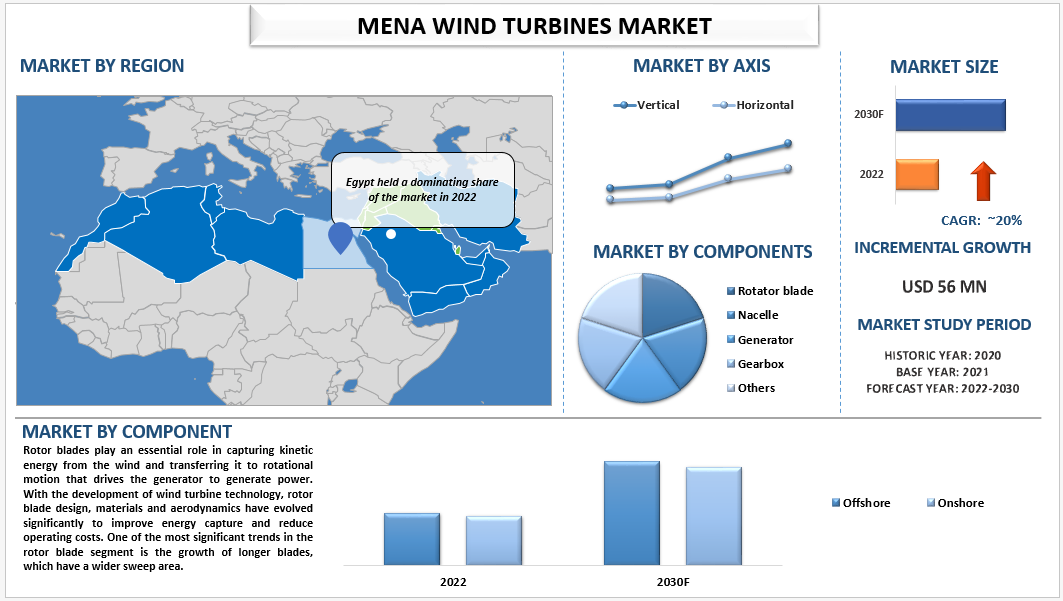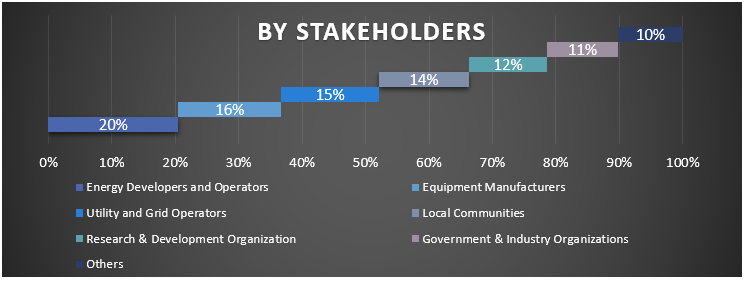MENA Wind Turbines Market: Current Analysis and Forecast (2023-2030)
$3999 – $6999
Emphasis on Axis Type (Vertical, and Horizontal); Component (Rotator Blade, Nacelle, Generator, Gearbox, and Others); and Installation (Offshore and Onshore); Country
| Pages: | 80 |
|---|---|
| Table: | 23 |
| Figure: | 24 |
| Report ID: | UMEP212443 |
| Geography: |

Report Description

The MENA Wind Turbines Market is expected to grow at a strong CAGR of 20% during the forecast period. In recent years, the wind turbine market has seen strong growth due to a combination of factors that have made wind a key player in the global energy mix. One of the main reasons for this growth is the growing recognition of wind as a clean and renewable alternative to traditional fossil fuels. Governments worldwide are setting ambitious targets for renewable energy, and wind turbines are playing a key role in achieving these targets. However, in recent years, many countries in the region have implemented plans to increase the share of renewable energy in their power mixes. UAE targets 44% renewable energy by 2050, while Saudi Arabia is aiming for 50% by 2030. This policy support for wind energy development has created an environment conducive to wind energy development, encouraging investment and driving technological innovation.
Some of the major players operating in the Siemens Gamesa Renewable Energy, S.A.U., Vestas, GENERAL ELECTRIC, Suzlon Energy Limited, goldwind, Envision Group, NORDEX SE, ENERCON GmbH, Cox Energy Solar S.A., Gicon. Several M&As along with partnerships have been undertaken by these players to facilitate customers with hi-tech and innovative products/technologies.
Insights Presented in the Report
“Based on the axis type, the market is segmented into vertical and horizontal. Vertical segment held a significant share of the market.”
Based on the axis type, the market is segmented into vertical and horizontal. Vertical segment held a significant share of the market. As offshore wind farms expand into deeper waters, they are able to take advantage of stronger, more consistent wind speeds, which can result in higher generation rates. As a result, specialized offshore wind turbine designs, foundations, and installation methods are in high demand, leading to an increase in the demand for offshore solutions and offshore-specific services. Another growing vertical is the development of wind turbine technology. Turbine design and engineering advances have led to more efficient and dependable turbines. Blade aerodynamics and drivetrain systems have been developed, as well as control mechanisms that optimize energy capture and reduce maintenance requirements. Integration of digital technologies (sensors and predictive analytics) has also led to condition-based maintenance, which improves operational efficiency and reduces downtime.
“Based on the Components, the market is segmented into rotator blade, nacelle, generator, gearbox and others. Rotator blade segment held a significant share of the market.”
Based on the Components, the market is segmented into rotator blade, nacelle, generator, gearbox and others. Rotator blade segment held a significant share of the market. Rotator blade have gained tremendous traction and growth will held a considerable share of the market during a forecast period. Rotor blades play an essential role in capturing kinetic energy from the wind and transferring it to rotational motion that drives the generator to generate power. With the development of wind turbine technology, rotor blade design, materials and aerodynamics have evolved significantly to improve energy capture and reduce operating costs. One of the most significant trends in the rotor blade segment is the growth of longer blades, which have a wider sweep area. This allows turbines to capture more energy from a larger volume of air, resulting in higher power generation, particularly in windy regions.
MENA Wind Turbines Market Report Coverage

“Egypt dominated the market.”
The adoption of wind turbines in Egypt has seen remarkable growth in recent years. This surge in popularity can be attributed to several factors. Firstly, the nation’s commitment to renewable energy sources has led to substantial investments in wind power infrastructure. Egypt’s favorable geographical location, particularly in regions such as the Gulf of Suez and the Red Sea, provides a consistent and robust wind resource, making it an ideal environment for wind energy projects. Moreover, the government’s initiatives to attract foreign investments and promote domestic renewable energy projects have spurred the development of wind farms across the country. This transition to wind energy not only contributes to Egypt’s environmental sustainability goals but also helps diversify its energy mix, reducing dependency on fossil fuels and enhancing energy security. As the adoption of wind turbines continues to gain momentum, Egypt is on a promising path towards a greener and more sustainable energy future
Reasons to buy this report:
- The study includes market sizing and forecasting analysis validated by authenticated key industry experts.
- The report presents a quick review of overall industry performance at one glance.
- The report covers an in-depth analysis of prominent industry peers with a primary focus on key business financials, product portfolios, expansion strategies, and recent developments.
- Detailed examination of drivers, restraints, key trends, and opportunities prevailing in the industry.
- The study comprehensively covers the market across different segments.
- Deep dive regional level analysis of the industry.
Customization Options:
The MENA Wind Turbines market can further be customized as per the requirement or any other market segment. Besides this, UMI understands that you may have your own business needs, hence feel free to connect with us to get a report that completely suits your requirements.

You can also purchase parts of this report. Do you want to check out a section wise
price list?
Research Methodology
Research Methodology for the MENA Wind Turbines Market Analysis (2023-2030)
Analyzing the historical market, estimating the current market, and forecasting the future market of the MENA Wind Turbines market were the three major steps undertaken to create and analyze the adoption of MENA Wind Turbines in major countries. Exhaustive secondary research was conducted to collect the historical market numbers and estimate the current market size. Secondly, to validate these insights, numerous findings and assumptions were taken into consideration. Moreover, exhaustive primary interviews were also conducted, with industry experts across the value chain of the MENA Wind Turbines market. Post assumption and validation of market numbers through primary interviews, we employed a top-down/bottom-up approach to forecasting the complete market size. Thereafter, market breakdown and data triangulation methods were adopted to estimate and analyze the market size of segments and sub-segments of the industry pertains to. Detailed methodology is explained below:
Analysis of Historical Market Size
Step 1: In-Depth Study of Secondary Sources:
Detail secondary study was conducted to obtain the historical market size of the MENA Wind Turbines market through company internal sources such as annual reports & financial statements, performance presentations, press releases, etc., and external sources including journals, news & articles, government publications, competitor publications, sector reports, third-party database, and other credible publications.
Step 2: Market Segmentation:
After obtaining the historical market size of the MENA Wind Turbines market, we conducted a detailed secondary analysis to gather historical market insights and share for different segments & sub-segments for major regions. Major segments are included in the report as axis type, components, and installation. Further country-level analyses were conducted to evaluate the overall adoption of testing models in that region.
Step 3: Factor Analysis:
After acquiring the historical market size of different segments and sub-segments, we conducted a detailed factor analysis to estimate the current market size of the MENA Wind Turbines market. Further, we conducted factor analysis using dependent and independent variables such as axis type, components, and installation of the MENA Wind Turbines market. A thorough analysis was conducted for demand and supply-side scenarios considering top partnerships, mergers and acquisitions, business expansion, and product launches in the MENA Wind Turbines market sector across the globe.
Current Market Size Estimate & Forecast
Current Market Sizing: Based on actionable insights from the above 3 steps, we arrived at the current market size, key players in the MENA Wind Turbines market, and market shares of the segments. All the required percentage shares split, and market breakdowns were determined using the above-mentioned secondary approach and were verified through primary interviews.
Estimation & Forecasting: For market estimation and forecast, weights were assigned to different factors including drivers & trends, restraints, and opportunities available for the stakeholders. After analyzing these factors, relevant forecasting techniques i.e., the top-down/bottom-up approach were applied to arrive at the market forecast for 2030 for different segments and sub-segments across the major markets. The research methodology adopted to estimate the market size encompasses:
- The industry’s market size, in terms of revenue (USD) and the adoption rate of the MENA Wind Turbines market across the major markets domestically
- All percentage shares, splits, and breakdowns of market segments and sub-segments
- Key players in the MENA Wind Turbines market in terms of products offered. Also, the growth strategies adopted by these players to compete in the fast-growing market
Market Size and Share Validation
Primary Research: In-depth interviews were conducted with the Key Opinion Leaders (KOLs) including Top Level Executives (CXO/VPs, Sales Head, Marketing Head, Operational Head, Regional Head, Country Head, etc.) across major regions. Primary research findings were then summarized, and statistical analysis was performed to prove the stated hypothesis. Inputs from primary research were consolidated with secondary findings, hence turning information into actionable insights.
Key Stakeholders of Wind Turbines Market in the MENA Region

Market Engineering
The data triangulation technique was employed to complete the overall market estimation and to arrive at precise statistical numbers for each segment and sub-segment of the MENA Wind Turbines market. The data was split into several segments & and sub-segments post studying various parameters and trends in the areas of axis type, components, and installation of the MENA Wind Turbines market.
The main objective of the MENA Wind Turbines Market Study
The current & future market trends of the MENA Wind Turbines market were pinpointed in the study. Investors can gain strategic insights to base their discretion for investments on the qualitative and quantitative analysis performed in the study. Current and future market trends determined the overall attractiveness of the market at a regional and country level, providing a platform for the industrial participant to exploit the untapped market to benefit from a first-mover advantage. Other quantitative goals of the studies include:
- Analyze the current and forecast market size of the MENA Wind Turbines market in terms of value (USD). Also, analyze the current and forecast market size of different segments and sub-segments
- Segments in the study include areas of axis type, components, and installation
- Define and analysis of the regulatory framework for the MENA Wind Turbines industry
- Analyze the value chain involved with the presence of various intermediaries, along with analyzing customer and competitor behaviors of the industry
- Major countries of regions studied in the report include Saudi Arabia, UAE, Egypt, Turkey, and the Rest of MENA
- Company profiles of the MENA Wind Turbines market and the growth strategies adopted by the market players to sustain in the fast-growing market
- Deep dive regional level analysis of the industry


